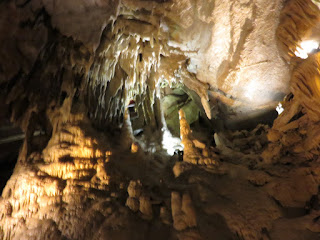 |
| Part of Frozen Niagara - Domes and Dripstones Tour |
 |
| 280 Stairs Down - Domes and Dripstones Tour |
 |
| Leaving a Large Dome Area - Domes and Dripstones Tour |
Mammoth Cave is the longest cave system in the world at over
400 miles, with what some believe over 600 more miles not yet discovered.
Don’t think of those miles as linear
miles.
Think of them as a plate of
spaghetti with tunnels above and below and crossing each other.
 |
| Rugged Passageway - Domes and Dripstones Tour |
Some of the cave tunnels are huge, smooth sided passageways
the size of a large subway station. Others are many-stories-tall, rounded
chambers like inside a monument.
Still
others are narrow, jagged passageways that you bend and stoop to pass
through.
In the areas that are not open
to the public, there are passageways you can only crawl through.
Much of the cave is dry where the river that carved it out
of the stone has been gone for millennia.
Others are damp and drippy and filled with artistic stalactites and
stalagmites. There is an underground
river with eyeless fish and crustaceans that have never seen the sun.
 |
| Domes and Dripstones Tour |
How was this cave and others like it in the area
formed?
Millennia ago Kentucky was
covered by a shallow sea.
The creatures
living there died and settled to the bottom, and the calcium in their bones or
carapaces created what would become 600 feet of limestone.
Then as the continents drifted, Kentucky was
under the delta of a rich river that laid down a sediment that became sandstone
and shale.
When the continents drifted
some more and Kentucky moved inland, rain water would seep through cracks in
the sandstone and shale cap rock and erode the softer limestone forming tunnels
for rivers of water trying to flow downhill to the Green River.
The sandstone and shale cap rock forms a hard
roof over the caves and keeps them from collapsing in on themselves.
 |
| Domes and Dripstones Tour |
 |
| Curtain of Limestone - Domes and Dripstones Tour |
We went on 2 cave tours led by wonderfully informative and engaging
National Park Rangers.
For the
Domes and Dripstones Tour, you take a bus to an entrance to
the cave in the middle of an old sink hole.
You descend a narrow tube that was carved by water long ago to drain
water out of a sinkhole.
The Park
Service has installed a winding staircase with 280 stairs down through the
channel.
Then you walk through narrow
tunnels to reach large domed open areas.
The tour ends at the Frozen Niagara area, which are gorgeous formations
still growing from dripping water.
The
walking is a little uneven at times, and there are many, many stairs.
There are areas with benches where you can
rest and learn about the cave.
The trip
takes 2 hours and is definitely worth it..
 |
| Interesting Stalactite Formations - Domes and Dripstones Tour |
The
Mammoth Passage
Tour starts at the historic opening of the cave and takes you through
cavernous, dry tunnels into the Rotunda, one of the largest rooms of the cave.
The narrative of this cave focuses on ways
the cave was used in history.
The
earliest explorers of the caves, pre-historic Native Americans, explored 12
miles back into the cave from 4,000 to 2,000 years ago.
They left behind charred river cane bundles
they burned to light their way,
grass
shoes that wore out walking over rocks, and bowls made from ghourds used for
mining minerals in the cave.
This part
of the cave also has the remains of saltpeter mining from the War of 1812.
The wood from the operation has been preserved
in the constant 54 degree climate of the cave.
Most of the walkways traversed in this tour are lined with paving
stones, with gentle inclines.
This trip
takes 1.5 hours and gave a very different view of the cave than our first trip,
though still wonderful.
 |
| Limestone Formations - Domes and Dripstones Tour |
 |
| Carnation on the Ceiling? - Domes and Dripstones Tour |
We also took the
Heritage
Walk above ground where another knowledgeable and helpful Ranger tells you
more about the early uses of the cave and focuses on a group of enslaved
African Americans who were the first explorers of many parts of the cave and
who served as guides to the wealthy guests who came to Kentucky just to see the
Mammoth Cave.
Stephen Bishop was so well
respected that his owner gave him credit for a map that Bishop drew of the
cave showing almost 10 miles of tunnels, half of which had been discovered by him.
Visitors to the cave in the 1830's to 1850's were so
impressed with Stephen Bishop that they would write about him in letters about their trips.
During this
time the cave was also used as a sanatorium for patients with TB. Another slave family, the Bransfords, served as guides with Stephen Bishop. Their descendents continued guiding in the cave for over 100 years to today with Ranger Bransford who currently gives cave tours.
The Visitors Center is wonderful with great and informative
exhibits about the geology of the cave, how it was formed, cave exploration
(both pre-historic and present day), the history of how the cave was used,
creatures that live in the cave and other topics.




















































